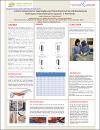IN VITRO COMPARISON OF TWO SINGLE LAYER HAND SEWN END-TO-END ANASTOMOSIS TECHNIQUES IN NORMAL EQUINE JEJUNUM A PILOT STUDY
| المؤلف | Al-Kharraz, Heba |
| المؤلف | Nader, Rahaf |
| المؤلف | Al-Asmakh, Maha |
| المؤلف | Johnson, Jessica P |
| تاريخ الإتاحة | 2020-10-26T08:49:56Z |
| تاريخ النشر | 2020 |
| اسم المنشور | Qatar University Annual Research an Exhibition 2020 (quarfe) |
| الاقتباس | AlKharraz H., Nader R., AlAsmakh M., Johnson J.P., "IN VITRO COMPARISON OF TWO SINGLE LAYER HAND SEWN END-TO-END ANASTOMOSIS TECHNIQUES IN NORMAL EQUINE JEJUNUM A PILOT STUDY", Qatar University Annual Research Forum and Exhibition (QUARFE 2020), Doha, 2020, https://doi.org/10.29117/quarfe.2020.0192 |
| الملخص | Background: The equine small intestine can be affected by a variety of disorders, which may require some form of bypass or anastomosis procedure. Several small intestinal anastomosis techniques have been reported in scientific literature with the intention to minimize post-operative complications, however to our knowledge there are no published descriptions of the hand- sewn end-to-end single layer simple continuous Appositional technique for equine jejunojejunostomy. Objective: To compare and evaluate differences in the single layer continuous Appositional and the single layer continuous Lembert with respect to construction time, leakage pressure and bursting pressure; for the purpose of small intestinal anastomosis in the horse. Hypothesis: We hypothesized that the time spent in the execution, leakage pressure and bursting pressure will be similar between the single layer continuous Lembert and the single layer simple continuous Appositional techniques. Since this is a pilot study; it is the first step to prove the efficacy of the Appositional technique by showing its similarity with the Lembert technique, considering the latter to be the 'gold standard'. Methodology: Thirty-Seven intestinal segments from two horses were used to compare the single layer continuous Appositional and single layer continuous Lembert techniques. The time taken to execute the anastomoses, and the number of bites taken for each pattern, were recorded. Biomechanical testing was performed to determine leakage pressure and bursting pressure. Statistical analysis was performed using GraphPad Prism 8. Result: The comparison in construction time between the Lembert group (mean, 24.23 mins, n=19) and the Appositional group (mean, 21.74 mins, n=18) were found to be statistically insignificant (P=0.3088). There was also no changes in Leakage pressure (P=0.3862) and bursting pressure (P=0.3135) between the two groups. Conclusion: This study has demonstrated that the Appositional technique is a viable alternative to the Lembert technique, with respect to construction time, leakage and bursting pressures, for the purpose of end-to-end jejunojejunal anastomosis in the horse. |
| اللغة | en |
| الناشر | Qatar University Press |
| الموضوع | Intestinal Anastomosis Lembert Technique Appositional Technique Equine Jejunojejunostomy. |
| النوع | Poster |
الملفات في هذه التسجيلة
هذه التسجيلة تظهر في المجموعات التالية
-
Theme 2: Population, Health & Wellness [118 items ]


